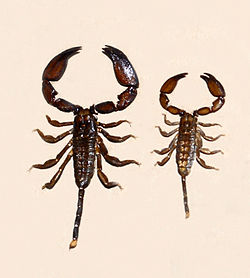| Liocheles australasiae | |
|---|---|
 | |
| Liocheles australasiae from Enggano Island. Museum specimens | |
| Scientific classification | |
| Domain: | Eukaryota |
| Kingdom: | Animalia |
| Phylum: | Arthropoda |
| Subphylum: | Chelicerata |
| Class: | Arachnida |
| Order: | Scorpiones |
| Family: | Hormuridae |
| Genus: | Liocheles |
| Species: | L. australasiae |
| Binomial name | |
| Liocheles australasiae (Fabricius, 1775) | |
| Synonyms | |
| |
Liocheles australasiae, the dwarf wood scorpion, is a species of scorpion belonging to the family Hormuridae. [1] [2] [3] [4]
